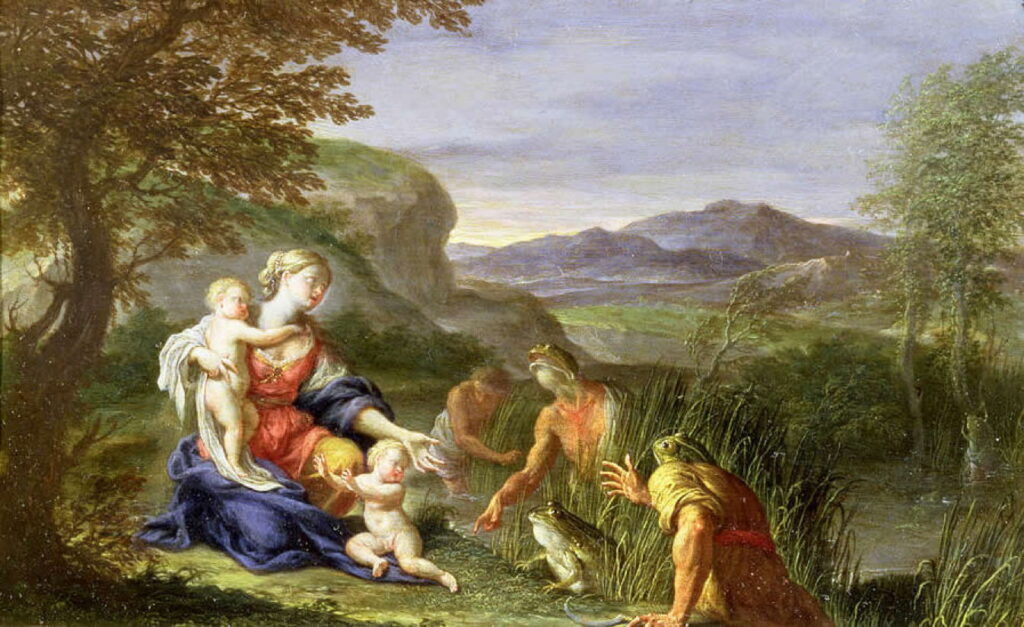Changing Paintings: 26 Latona and the Lycian peasants

For Ovid’s next myth about the lesser-known goddess Latona, he steps back in time to when her twins, Apollo and Diana, were born, in a story about divine retribution of a less savage kind.
Long ago in Lycia, at the western end of the south coast of modern Turkey, country people scorned the worship of Latona. The unnamed narrator of this myth was taken by his father to see an old altar dedicated to the goddess, located among reeds, and marking the birth of her twins. Latona had fled here to give birth in the heat, where she could avoid Juno.
When the twins had drunk her milk and she was dry and thirsty under the hot sun, Latona saw a small lake among marshes, where local peasants were cutting reeds. She went down and was about to drink from the lake when those locals stopped her. Latona told them that drinking the water was a common right, and she only intended to drink and not to bathe in it.
The locals continued to prevent her, threatening her and hurling insults, before stirring up the mud at the bottom of the lake, to literally muddy the water. Latona’s thirst was replaced by anger, and she cursed them to remain in that pool forever by turning them into frogs, who foolishly muddy their own pools.
Jacopo Tintoretto (c 1518-1594), Lycian Peasants Changed Into Frogs (1541-42) (E&I 14), oil on panel, dimensions not known, Galleria Estense, Modena, Italy. Image by Sailko, via Wikimedia Commons.
Tintoretto’s simple panel of Lycian Peasants Changed Into Frogs from 1541-42 tells this story in just five figures. This was one of a series of which fourteen have survived, telling myths from Ovid’s Metamorphoses. They were the artist’s first substantial commission, and decorated a room in a palace near San Marco in Venice.
Tintoretto (Jacopo Robusti) (1519–1594), Latona Changing the Lycian Peasants into Frogs (1545-48), oil on panel, 22.6 × 65.5 cm, Courtauld Institute of Art, London. Wikimedia Commons.
Tintoretto’s lovely panel of Latona Changing the Lycian Peasants into Frogs from 1545-48 is one of the earliest of modern accounts of Ovid’s story. Latona rests a baby on each hip as she tries to enlist the co-operation of the Lycians, who are becoming more froglike but haven’t yet been transformed.
Annibale Carracci (1560–1609), Latona and the Lycian Peasants (date not known), oil on canvas, 90.6 x 78 cm, Arcidiecézní muzeum Kroměříž, Olomouc Museum of Art, Kroměříž, The Czech Republic. Wikimedia Commons.
Annibale Carracci’s Latona and the Lycian Peasants probably from 1590-1620 is truly masterly. Latona is here placing her curse on the locals, and behind them one appears to have already been transformed into a frog. Although the babies’ heads are disproportionately small (as was the case for several centuries), they and their mother are realistically portrayed, and contrast markedly with the uncouth and obdurate locals.
Jan Brueghel the Elder (1568–1625), Latona and the Lycian Peasants (1595-1610), oil on panel, 37 × 56 cm, Rijksmuseum Amsterdam, Amsterdam, The Netherlands. Wikimedia Commons.
Jan Brueghel the Elder’s panel showing Latona and the Lycian Peasants (1595-1610) is set in a dense forest, probably quite inappropriate for Lycia, where the locals are busy cutting reeds and foraging. Latona, at the bottom left, is seen remonstrating with a peasant, over to the right. As the detail below shows, the goddess is in need, as are her babies. The peasant closest to her, brandishing his fist, is already rapidly turning into a frog. There are many other frogs around, including a pair at the bottom left corner, near the feet of one of the infants.
Jan Brueghel the Elder (1568–1625), Latona and the Lycian Peasants (detail) (1595-1610), oil on panel, 37 × 56 cm, Rijksmuseum Amsterdam, Amsterdam, The Netherlands. Wikimedia Commons.
David Teniers the Younger (1610–1690), Latona and the Frogs (c 1640–50), oil on copper, 24.8 × 38.1 cm, Fine Arts Museums of San Francisco, San Francisco, CA. Wikimedia Commons.
David Teniers the Younger’s Latona and the Frogs from around 1640–50 tells the story well, showing the Lycians being transformed for refusing to help the goddess.
Francesco Trevisani (1656–1746), Latona and the Frogs (date not known), oil on copper, 16.1 × 26.3 cm, Private collection. Wikimedia Commons.
Francesco Trevisani’s Latona and the Frogs from the late seventeenth or early eighteenth century is, like Tenier’s, painted in oil on copper. Even as his peasants are turning into frogs, they’re still refusing to let Latona drink from their lake.
François Lemoyne (1688–1737), Latona and the Peasants of Lycia (1721), oil on canvas, 77.5 × 97.8 cm, Portland Art Museum, Portland, OR. Wikimedia Commons.
François Lemoyne’s Latona and the Peasants of Lycia (1721) stops short of showing the metamorphosis, or any frogs, but Latona and the peasants are clearly engaged in their dispute.
Johann Georg Platzer (1704–1761), Latona Turning the Lycian Peasants into Frogs (c 1730), oil on copper, 21.6 × 30.5 cm, Minneapolis Institute of Art, Minneapolis, MN. Wikimedia Commons.
Johann Georg Platzer’s Latona Turning the Lycian Peasants into Frogs (c 1730) is another fine work on copper showing the key elements of the story, including the macabre appearance of the peasants as they are transformed.
Unknown Artist, Italian Landscape with Latona and the Lycian Peasants (c 1750), oil on canvas, 64 × 76 cm, location not known. Wikimedia Commons.
The artist who painted this Italian Landscape with Latona and the Lycian Peasants sometime in the middle of the eighteenth century hasn’t been identified. However, it depicts the story well, with the heads of two peasants already assuming the form of frogs.
Gabriel Guay (1848–1923), Latona and the Peasants (1877), oil, dimensions not known, Château du Roi René, Peyrolles, Provence, France. Wikimedia Commons.
The story survived in narrative painting well into the latter half of the nineteenth century, when Gabriel Guay painted his Latona and the Peasants (1877). Latona and her babies now seem not just real but almost contemporary, which minimises her divinity. The peasants are here engaged in muddying the waters.
Guay was a pupil of Jean-Léon Gérôme, and went on to become a professor at the École des Beaux-Arts in Paris. His first painting was accepted for the Paris Salon in 1873, making this one of his earlier works. Despite winning silver medals at the Universal Expositions in Paris in 1889 and 1900, and sustained success at the Salon, his work is now almost entirely forgotten.


